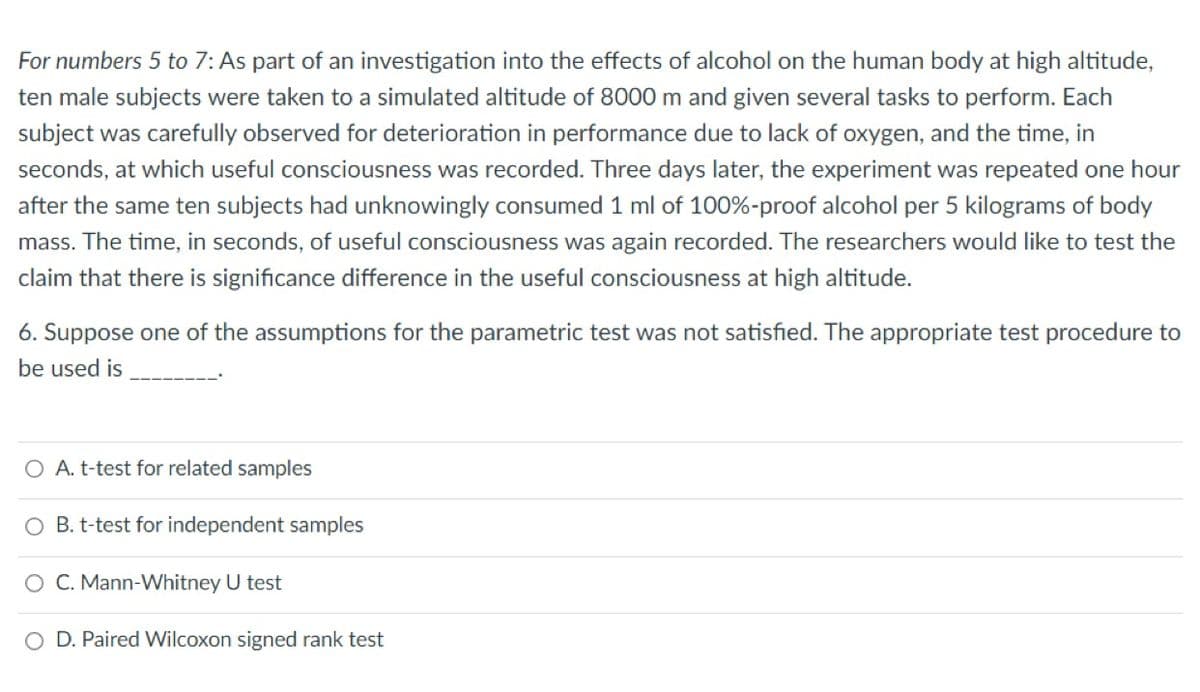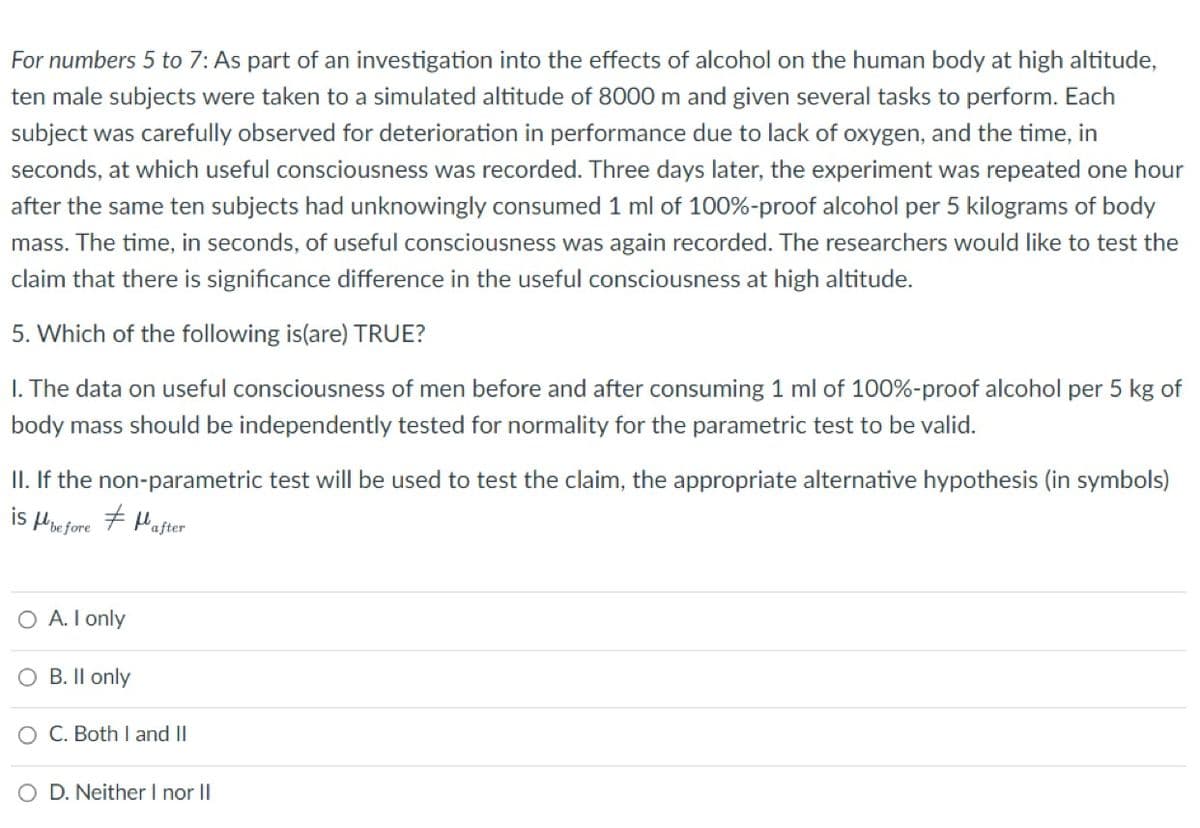For numbers 5 to 7: As part of an investigation into the effects of alcohol on the human body at high altitude, ten male subjects were taken to a simulated altitude of 8000 m and given several tasks to perform. Each subject was carefully observed for deterioration in performance due to lack of oxygen, and the time, in seconds, at which useful consciousness was recorded. Three days later, the experiment was repeated one hour after the same ten subjects had unknowingly consumed 1 ml of 100%-proof alcohol per 5 kilograms of body mass. The time, in seconds, of useful consciousness was again recorded. The researchers would like to test the claim that there is significance difference in the useful consciousness at high altitude. 6. Suppose one of the assumptions for the parametric test was not satisfied. The appropriate test procedure to be used is
For numbers 5 to 7: As part of an investigation into the effects of alcohol on the human body at high altitude, ten male subjects were taken to a simulated altitude of 8000 m and given several tasks to perform. Each subject was carefully observed for deterioration in performance due to lack of oxygen, and the time, in seconds, at which useful consciousness was recorded. Three days later, the experiment was repeated one hour after the same ten subjects had unknowingly consumed 1 ml of 100%-proof alcohol per 5 kilograms of body mass. The time, in seconds, of useful consciousness was again recorded. The researchers would like to test the claim that there is significance difference in the useful consciousness at high altitude. 6. Suppose one of the assumptions for the parametric test was not satisfied. The appropriate test procedure to be used is
Mathematics For Machine Technology
8th Edition
ISBN:9781337798310
Author:Peterson, John.
Publisher:Peterson, John.
Chapter20: Ratio And Propor Tion
Section: Chapter Questions
Problem 46A
Related questions
Question

Transcribed Image Text:For numbers 5 to 7: As part of an investigation into the effects of alcohol on the human body at high altitude,
ten male subjects were taken to a simulated altitude of 8000 m and given several tasks to perform. Each
subject was carefully observed for deterioration in performance due to lack of oxygen, and the time, in
seconds, at which useful consciousness was recorded. Three days later, the experiment was repeated one hour
after the same ten subjects had unknowingly consumed 1 ml of 100%-proof alcohol per 5 kilograms of body
mass. The time, in seconds, of useful consciousness was again recorded. The researchers would like to test the
claim that there is significance difference in the useful consciousness at high altitude.
6. Suppose one of the assumptions for the parametric test was not satisfied. The appropriate test procedure to
be used is
O A. t-test for related samples
O B. t-test for independent samples
O C. Mann-Whitney U test
O D. Paired Wilcoxon signed rank test

Transcribed Image Text:For numbers 5 to 7: As part of an investigation into the effects of alcohol on the human body at high altitude,
ten male subjects were taken to a simulated altitude of 8000 m and given several tasks to perform. Each
subject was carefully observed for deterioration in performance due to lack of oxygen, and the time, in
seconds, at which useful consciousness was recorded. Three days later, the experiment was repeated one hour
after the same ten subjects had unknowingly consumed 1 ml of 100%-proof alcohol per 5 kilograms of body
mass. The time, in seconds, of useful consciousness was again recorded. The researchers would like to test the
claim that there is significance difference in the useful consciousness at high altitude.
5. Which of the following is(are) TRUE?
1. The data on useful consciousness of men before and after consuming 1 ml of 100%-proof alcohol per 5 kg of
body mass should be independently tested for normality for the parametric test to be valid.
II. If the non-parametric test will be used to test the claim, the appropriate alternative hypothesis (in symbols)
#after
is before
O A. I only
B. II only
O C. Both I and II
O D. Neither I nor II
Expert Solution
This question has been solved!
Explore an expertly crafted, step-by-step solution for a thorough understanding of key concepts.
Step by step
Solved in 3 steps

Recommended textbooks for you

Mathematics For Machine Technology
Advanced Math
ISBN:
9781337798310
Author:
Peterson, John.
Publisher:
Cengage Learning,

Algebra: Structure And Method, Book 1
Algebra
ISBN:
9780395977224
Author:
Richard G. Brown, Mary P. Dolciani, Robert H. Sorgenfrey, William L. Cole
Publisher:
McDougal Littell


Mathematics For Machine Technology
Advanced Math
ISBN:
9781337798310
Author:
Peterson, John.
Publisher:
Cengage Learning,

Algebra: Structure And Method, Book 1
Algebra
ISBN:
9780395977224
Author:
Richard G. Brown, Mary P. Dolciani, Robert H. Sorgenfrey, William L. Cole
Publisher:
McDougal Littell


Algebra & Trigonometry with Analytic Geometry
Algebra
ISBN:
9781133382119
Author:
Swokowski
Publisher:
Cengage